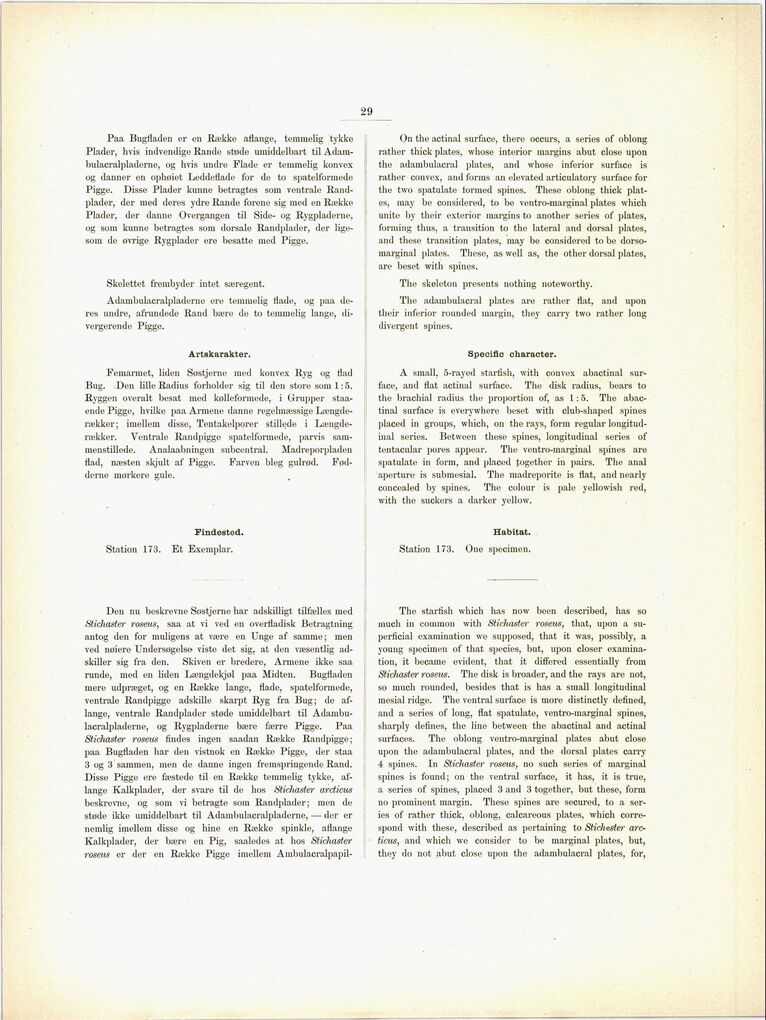
Full resolution (JPEG) - On this page / på denna sida - Sidor ...

<< prev. page << föreg. sida << >> nästa sida >> next page >>
Below is the raw OCR text
from the above scanned image.
Do you see an error? Proofread the page now!
Här nedan syns maskintolkade texten från faksimilbilden ovan.
Ser du något fel? Korrekturläs sidan nu!
This page has never been proofread. / Denna sida har aldrig korrekturlästs.
29
Paa Bugfladen er en Række aflange, temmelig tykke
Plader, hvis indvendige Rande støde umiddelbart til
Adam-bulacralpladerne, og hvis undre Flade er temmelig konvex
og danner en ophøiet Leddeflade for de to spatelformede
Pigge. Disse Plader kunne betragtes som ventrale
Randplader, der med deres ydre Rande forene sig med en Række
Plader, der danne Overgangen til Side- og Rygpladerne,
og som kunne betragtes som dorsale Randplader, der
ligesom de øvrige Rygplader ere besatte med Pigge.
Skelettet frembyder intet særegent.
Adambulacralpladerne ere temmelig flade, og paa
deres undre, afrundede Rand bære de to temmelig lange,
divergerende Pigge.
Artskarakter.
Femarmet, liden Søstjerne med konvex Ryg og flad
Bug. .Den lille Radius forholder sig til den store som 1:5.
Ryggen overalt besat med kølleformede, i Grupper
staaende Pigge, hvilke paa Armene danne regelmæssige
Længderækker; imellem disse, Tentakelporer stillede i
Længderækker. Ventrale Randpigge spatelformede, parvis
sammenstillede. Analaabningen subcentral. Madreporpladen
flad, næsten skjult af Pigge. Farven bleg gulrød.
Fødderne mørkere gule.
Pindested.
Station 173. Et Exemplar.
Den nu beskrevne Søstjerne har adskilligt tilfælles med
Stichaster rosens, saa at vi ved en overfladisk Betragtning
antog den for muligens at være en Unge af samme; men
ved nøiere Undersøgelse viste det sig, at den væsentlig
adskiller sig fra den. Skiven er bredere, Armene ikke saa
runde, med en liden Længdekjøl paa Midten. Bugfladen
mere udpræget, og en Række lange, flade, spatelformede,
ventrale Randpigge adskille skarpt Ryg fra Bug; de
aflange, ventrale Randplader støde umiddelbart til
Adambulacralpladerne, og Rygpladerne bære færre Pigge. Paa
Stichaster rosens findes ingen saadan Række Randpigge;
paa Bugfladen har den vistnok en Række Pigge, der staa
3 og 3 sammen, men de danne ingen fremspringende Rand.
Disse Pigge ere fæstede til en Række temmelig tykke,
aflange Kalkplader, der svare til de hos Stichaster arcticus
beskrevne, og som vi betragte som Randplader; men de
støde ikke umiddelbart til Adambulacralpladerne, — der er
nemlig imellem disse og hine en Række spinkle, aflange
Kalkplader, der bære en Pig, saaledes at hos Stichaster
rosens er der en Række Pigge imellem Ambulacralpapil-
On the actinal surface, there occurs, a series of oblong
rather thick plates, whose interior margins abut close upon
the adambulacral plates, and whose inferior surface is
rather convex, and forms an elevated articulatory surface for
the two spatulate tormed spines. These oblong thick
plates, may be considered, to be ventro-marginal plates which
unite by their exterior margins to another series of plates,
forming thus, a transition to the lateral and dorsal plates,
and these transition plates, may be considered to be
dorso-marginal plates. These, as well as, the other dorsal plates,
are beset with spines.
The skeleton presents nothing noteworthy.
The adambulacral plates are rather flat, and upon
their inferior rounded margin, they carry two rather long
divergent spines.
Specific character.
A small, 5-rayed starfish, with convex abactinal
surface, and flat actinal surface. The disk radius, bears to
the brachial radius the proportion of, as 1:5. The
abactinal surface is everywhere beset with club-shaped spines
placed in groups, which, on the rays, form regular
longitudinal series. Between these spines, longitudinal series of
tentacular pores appear. The ventro-marginal spines are
spatulate in form, and placed together in pairs. The anal
aperture is submesial. The madreporite is flat, and nearly
concealed by spines. The colour is pale yellowish red,
with the suckers a darker yellow.
Habitat.
Station 173. One specimen.
The starfish which has now been described, has so
much in common with Stichaster roseus, that, upon a
superficial examination we supposed, that it was, possibly, a
young specimen of that species, but, upon closer
examination, it became evident, that it differed essentially from
Stichaster roseus. The disk is broader, and the rays are not,
so much rounded, besides that is has a small longitudinal
mesial ridge. The ventral surface is more distinctly defined,
and a series of long, flat spatulate, ventro-marginal spines,
sharply defines, the line between the abactinal and actinal
surfaces. The oblong ventro-marginal plates abut close
upon the adambulacral plates, and the dorsal plates carry
4 spines. In Stichaster roseus, no such series of marginal
spines is found; on the ventral surface, it has, it is true,
a series of spines, placed 3 and 3 together, but these, form
no prominent margin. These spines are secured, to a
series of rather thick, oblong, calcareous plates, which
correspond with these, described as pertaining to Stichaster
arcticus, and which we consider to be marginal plates, but,
they do not abut close upon the adambulacral plates, for,
<< prev. page << föreg. sida << >> nästa sida >> next page >>